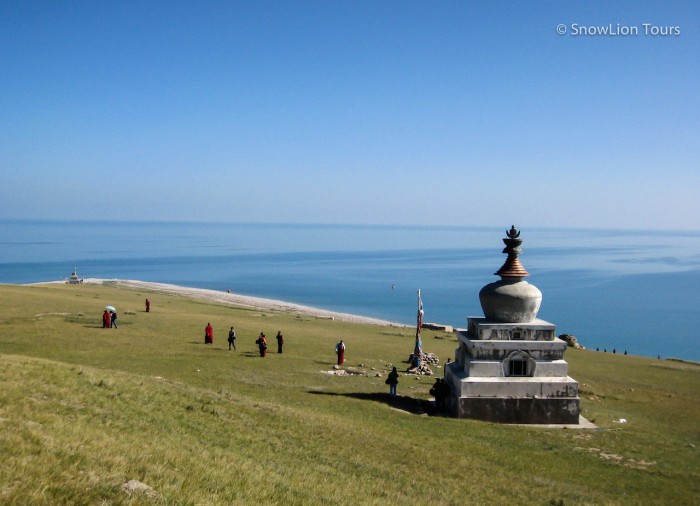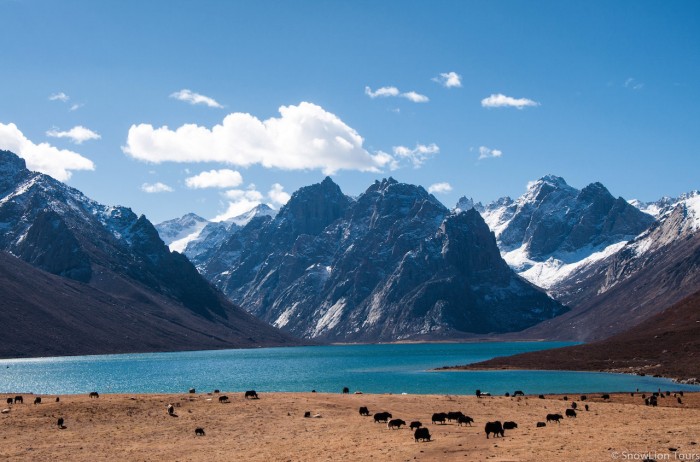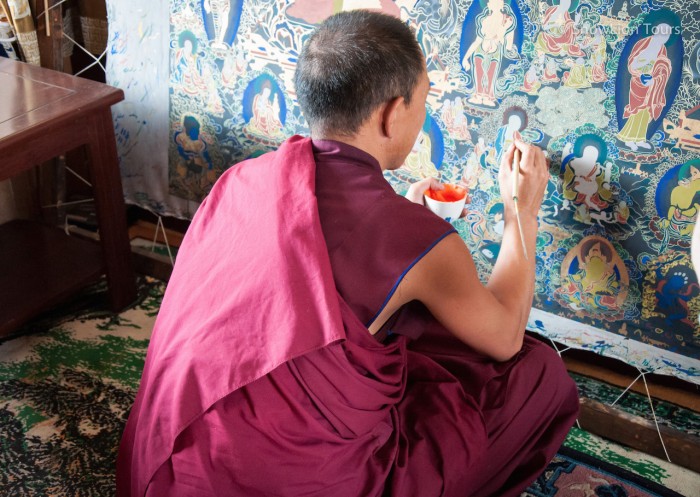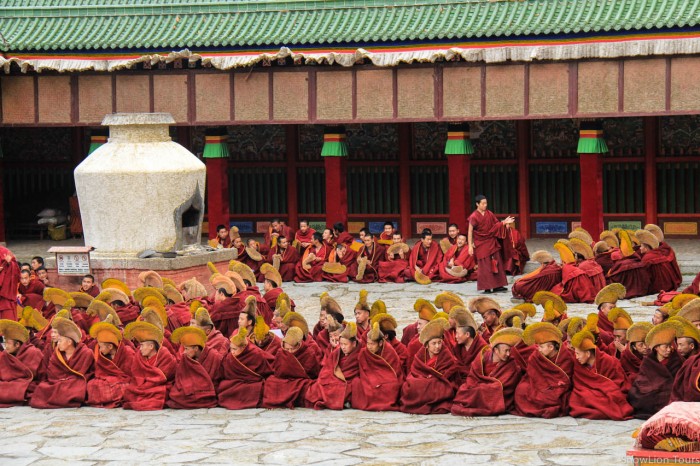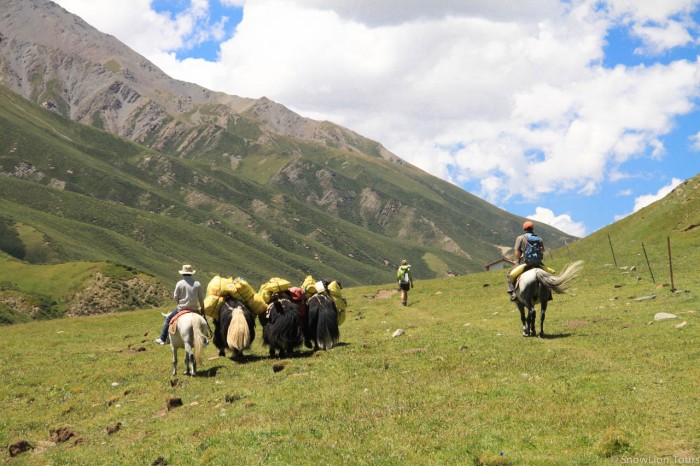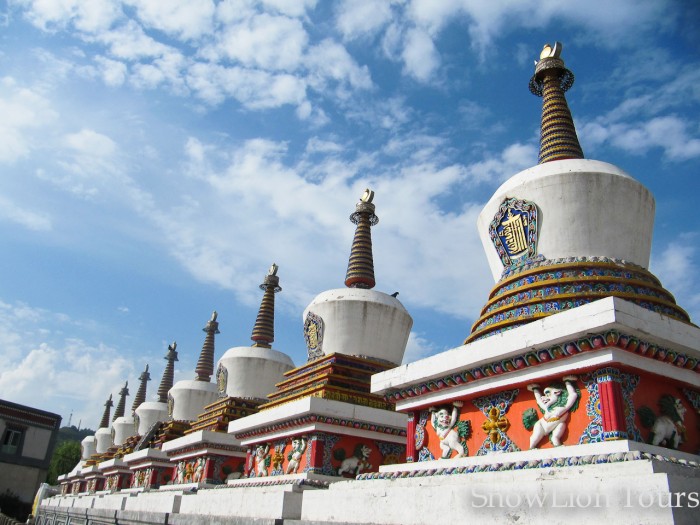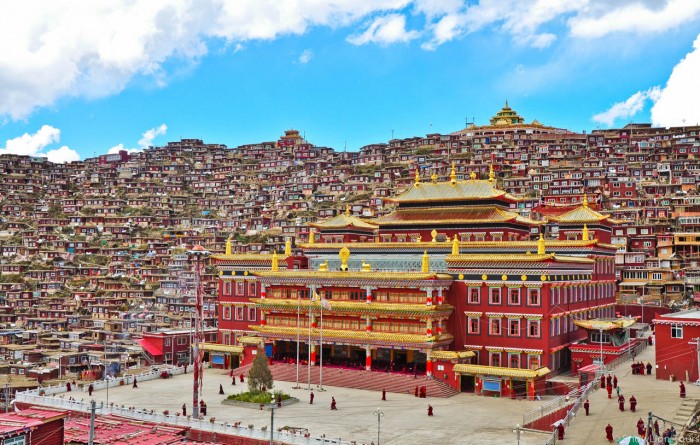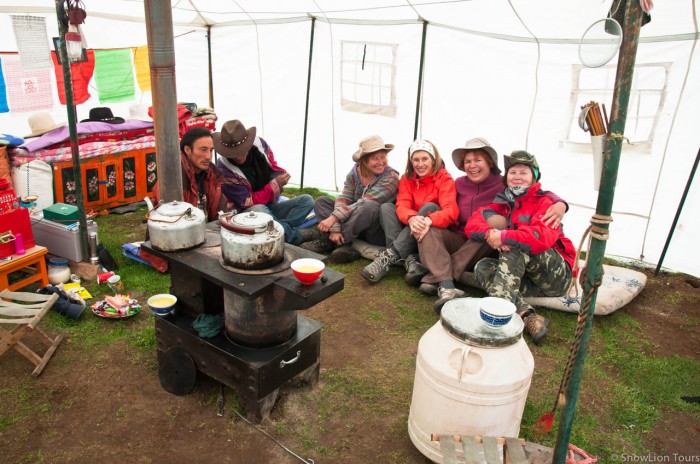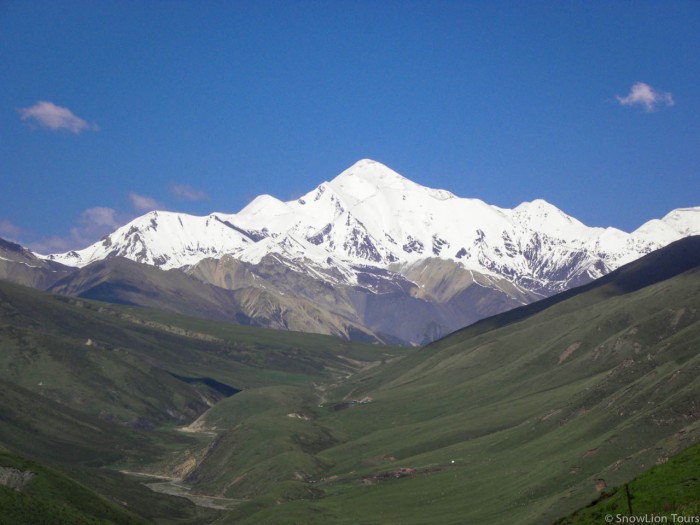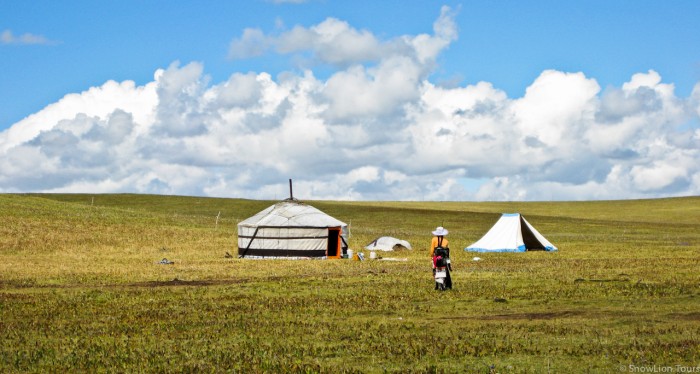Day 1: Arrive in Xining (2200 m) Qinghai Province
Pick up at the Xining airport, transfer to your hotel and get settled. If time allows explore Xining on your own: hike up to Beishan mountain, where you can visit ancient Taoist temple, or go to the Tibetan Medical and Cultural Museum. In the afternoon group gets together in the Tibetan traditional restaurant. Here enjoy Tibetan cuisine, meet your guide and travel mates.
Day 2: Xining – Shachung monastery – Rebkong (2500 m) Qinghai Province
In the morning, drive to Shachung monastery – one of the most beautiful monasteries in Amdo, located atop of the hill cliff from where you can see a stunning view of Yellow River in the big open valley. Afterwards, drive to Rebkong – art center of Tibet Buddhism. Here, visit four major monasteries – Rongwu, Gomar, Upper and Lower Sengeshung, Tibetan thangka galleries and artists’ villages.
Day 3: Rebkong – Gangya grassland – Labrang (2900 m) Gansu Province
In the morning, visit Sangeshung Artists village and Monastery. Afterwards, head to Labrang via the famous Ganjia grassland. Labrang, Amdo’s most famous monastery, is located in the small town of Xiahe. It is one of six great Gelugpa monasteries in Tibet, was found in 1709 by the First Jamyang Zhepa Ngawang Tsondru. Labrang sits at 2900m with high mountains and alpine forests surrounding it. It is a popular pilgrimage destination for Tibetans and is home to over 1700 monks.
Day 4: Labrang – Taktsang Lhamo / Langmusi ( 3300 m) Gansu Province
Travel from Labrang to the beautiful Tibetan town of Taktsang Lhamo (Langmusi). Taktsang means “Tigers Cave”, and Lhamo means “Goddess”. It is a township on the border of Sichuan and Gansu provinces. Here you will have chance to visit two major monasteries: Kirti Namgyal Dechenling and Sertang Monastery (locally called Lhamo gompa), both built in 18th century. Taktsang Lhamo is associated with Padmasambhava and Shridevi, and was frequently visited by yogis and meditation masters of the past. There is a gorge with several old meditation caves located in the area. Besides hermit caves and two monasteries, Taktsang Lhamo is famous for its sky burial site located atop of the hill. This is a sacred ground for the sky burial process.
Day 5: Taktsang Lhamo hike or Horseback Trek Gansu Province
Taktsang Lhamo is a great place to do a short horseback trek to explore grasslands that are home to nomadic Tibetans. In the morning you will meet your nomadic crew who will teach you basic skills of horseback riding. Then you’ll start your trek across nomadic grasslands with amazing mountain scenery. Spend the night in a yak hair tent. It is unique opportunity to experience nomadic lifestyle, try locally made yak yogurt and milk tea, study how to graze yaks and catch horses by a ‘lasso’ rope. This place also offer great hiking opportunities.
The horseback fee is not included in the tour package.
Day 6: Taktsang Lhamo – Machu grassland – Jigdril (3800 m) Qinghai Province
Come back to Taktsang Lhamo in the morning, meet your driver and continue to Jigdril via Machu grassland where you can see many Tibetan nomadic camps. Jigdril, also known as Jiuzhi in Chinese, is a county in Golog Tibetan Autonomous Prefecture in southeast Qinghai province and a part of Amdo region of the Tibetan Plateau. Here visit Tarthang monastery which was found in the 19th century by the 7th throne-holder of the great Nyingma monastery in Pelyul in Kham. Tarthang monastery belongs to Nyingma sect of Tibetan Buddhism, it quickly became the largest and most influential branch of Pelyul in the entire area with more than 1200 monks and 30 incarnated lamas.
Day 7: Jigdril – Mt. Nyenbo Yurtse – Baima / Padma (4100 m) Qinghai Province
Drive to the west range of Mount Nyenpo Yurtse (5933 m) – holy mountain of southern Golok, which is considered as a birthplace of the nomadic Golok tribes. The mountain range has 14 peaks over 5000 meters. The steep snow-capped ridges of the mountain are surrounded by holy glacier lakes, such as Tsochen and Tsochung which steams flowing into the Yellow River, and lakes Tso Nagma and Nojin Tso which streams flowing into headwaters of Gyarong. The Nyenbo Yurtse Base Camp is located at 4000 meters, and climbing expeditions can also be organized. After enjoying holy mount scenery we’ll continue driving to Padma (Pema). This area is one of the most beautiful parts in Tibet. It lies south of the watershed range that divides the rolling grasslands of the Yellow River valley from the forested gorges of Gyarong. There are 23 monasteries scattered throughout the valleys of the county, 20 of which are Nyingma monasteries, and 3 are the monasteries of Kagyu and Jonang schools of Tibetan Buddhism.
Day 8: Padma – Sertar Larung Gar (4000 m) Sichuan Province
Drive through nomadic grasslands surrounded by mountain ranges, stop for taking pictures and short hikes, breathing fresh mountain air. In the afternoon you’ll reach Serta (Sertal) county, which has a large number of monasteries representing only one school of Tibetan Buddhism – the Nyingma tradition. There are 31 Nyingma monasteries in the county. Here you will visit Larung Gar – largest Buddhist Institution on the Tibetan Plateau.
Day 9: Sertar Larung Gar / Monastic college Sichuan Province
You will spend whole day exploring Larung Gar – Larung Five Sciences Buddhist Academy, which is housing thousands of students. This Nyingmapa institution was originally found by Dudjom Lingpa in the late 19th century, but its owes its recent revival to the khenpo Jigme Phuntsok, who was the spiritual teacher for thousands of Tibetan and Chinese monks, nuns and lay people. Nowadays thousands of ‘vow-holders’ as well as a some lay people are studying Buddhism here. The whole area of Larung Gar is divided into two parts: monks live on the right slope of the mountain, while nuns live on its left slope. Although Serta is located in Kham, it traditionally was a part of Golok prefecture in Amdo, a large percentage of the native people in this area speak Amdo dialect of Tibetan as their first language. There is a large number of incarnated lamas as well as ‘khenpos’ – holders of Bachelor’s degrees in Buddhism, live, teach and study in Larung Gar at the present time. The main building at Larung Gar are on the three levels: the lowest containing an assortment of small temples and concrete structures. The main assembly hall and the famous monastic college (shedra) of Larung Gar are at the mid-level, and the third level or the hilltop is dominated by two spectacular chapels: Tonpei Dekhang – containing a large Reclining Buddha, and the three-dimensional Gyutrul Lhakhang. Spend the night in the monastery guest houses located atop of the hill from where you can see the whole view of Larung Gar.
Day 10. Sertar – Darlag / Da Ri Xian (3970m) Qinghai Province
Today is a full day driving through some of the most remote and beautiful areas of Golog.
Day 11: Darlag – Mt. Amnye Machen – Tsigorthang / Xinghai (3300m)Qinghai Province
In the morning, we will head to the famous snow mountain – Mt. Amnye Machen. This is one of the four most sacred mountains in entire Tibet along with Mt. Kailash in Ngari, Minyak Gongkar in Sichuan, Mt. Karwa Karpo in Sichuan. After spend sometime at the bottom of this holy mountain, we drive to Tsigortang county (Xinghai in Chinese), which lays the tableland west of the bend of the Yellow River, formed by the Mt. Amnye Machen range. Xinghai is one of the region which well preserved the culture of nomads. From July – October, you will see many nomadic tents with their yaks and sheep scattering in the grassland of Tsigorthang.
Wild Animals like Wild Donkey, wolves, fox, birds are can be seen along your driving way.
Day 12. Xinghai – Drekar Tredzong Monastery – Chabcha ( 2850m) Qinghai Province
Tsigortang town is situated near the scenic power-place of Drakar Tredzong – ‘white monkey fortress’, which is considered as one of the most important sacred sites in Amdo. There are about 500 monks and 20 Buddhist mentors staying here. Hermits and Tibetan yogis are doing their retreats in the caves located in the mountain cliffs in this area. If time permits, you can do a 2.5 hours hike around the monastery with great view of the monastery and nomads nearby. Afterwards, we will drive Chabcha. Chabcha is a middle sized modern town. It’s the center of economy, culture and politic of Hainan Tibetan Autonomous Prefecture. Stay in Chabcha.
Day 13: Chabcha – Qinghai Lake / Lake Kokonor – Kumbum Monastery – Xining Qinghai Province
Drive to Kokonor lake (Qinghai Lake or Tso Ngonpo) – the largest lake in China. Take pictures of the blooming yellow flowers along the shores of the lake and visit the nomads herding yaks and sheep. Afterwards, Drive to Kumbum monastery which is one of the six great monasteries of the Gelugpa school of Tibetan Buddhism. This monastery is also famous for being the birthplace of the great religious reformer Tsongkhapa. At the ends, we will drive to Xining and drop you off at your hotel. Our service ends.






